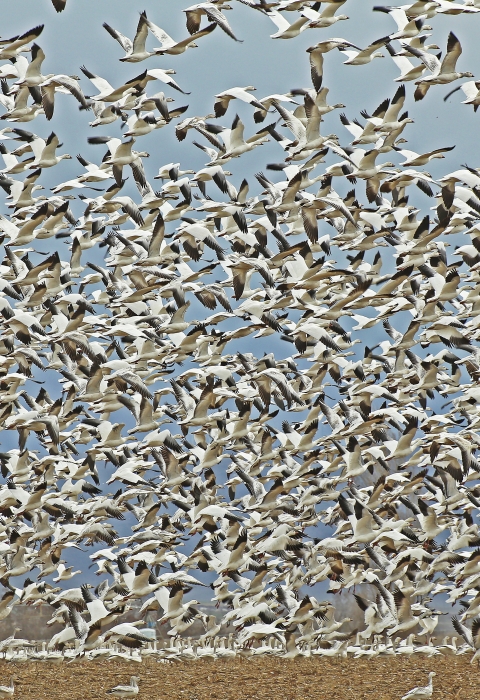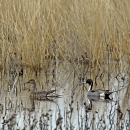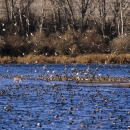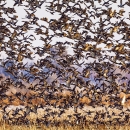Visit Us
A visit to McNary NWR is always worth the time—especially when it’s only minutes from the Tri-Cities of Washington (Kennewick, Pasco, Richland).
Hours
Public use areas of the refuge are open daily during daylight hours (sunrise to sunset), except as modified by fishing and hunting regulations (see our Regulations page). The headquarters are open 8:00 a.m. to 4:00 p.m., Monday through Thursday, and 8:00 a.m. to 3:30 p.m. on Friday. The hours of operation for the Environmental Education Center are the same if staff and volunteers are available. Please phone ahead (509-546-8300) to avoid disappointment.
Accessibility
The new McNary Environmental Education Center is fully accessible (barrier-free). The Quail trail is a 2.5 mile (round trip) interpretive trail that is hard-surfaced and accessible to wheelchairs, as is the birdwatching blind it allows access to.
The McNary National Wildlife Refuge provides three barrier-free (accessible) hunting blinds—the Burbank Slough Fee Hunt Unit hunting blinds #8 and #2 are designated accessible blinds, as is the Peninsula Unit's #11 blind. The refuge and its volunteers are in the process of improving these blinds and striving to make them and their trail access consistent with ADA standards. If you have concerns, please contact the refuge prior to use.
There are also two accessible fishing piers. The larger and more popular accessible fishing pier is located on the Two Rivers Unit at Quarry Pond. The second and smaller accessible fishing pier is located on the Wallula Unit at the boat launch and allows disabled fishermen to fish the Walla Walla River.
Entrance to the refuge is only permitted from designated public entrance areas. Parking is only allowed in designated parking areas. Vehicles, including bicycles, motorcycles and ATVs, are allowed only on designated routes of travel and must be parked in designated parking areas. There are about 20 miles of roads maintained for public use on the refuge. Of these roads, 17 miles are unpaved, with graveled or natural dirt surfaces. Gates have been installed along certain roads to minimize impact and disturbance at certain times, yet allow refuge staff access for maintenance activities or wildfire suppression. Please contact the refuge if you have questions on road access.
Access is also permitted by boat at any suitable point along the approximately 14 miles of refuge shoreline fronting the Columbia River. Please note that while boating provides access to refuge islands, all islands are closed to public access for the protection of the many species of birds that depend upon them for critical resting, nesting, roosting and foraging habitat. In general, all units of the McNary National Wildlife Refuge are open to the public year round, except the following: Strawberry Island, Sanctuary Pond (closed to hunting, except for two sites, see the Hunting Regulations), and the Burbank Slough Fee Hunt Area.
Overnight camping is not available on the refuge. However, approximately one mile from the Burbank Office, on the northeast corner of the intersection of State Highway 12 and Highway 124 (Ice Harbor Drive), is Hood Park, managed by the Army Corp of Engineers, Walla Walla District.
Weather
The McNary National Wildlife Refuge lies in the semi-arid shrub-steppe Columbia Basin Plateau. Average monthly temperatures range from a low of 31° F in January, to a high of 76° F in July. Daily maximum temperatures vary from an average of 35° F in late December and early January to 100° F; in late July. With an annual precipitation of 6.8 inches, mostly occurring during the late autumn and winter, rain usually does not limit visitation. Snowfall accounts for about 38% of all precipitation from December though February. Visitors to the refuge can expect to encounter wind. Maximum wind speeds and wind days occur along the Stateline and Juniper Canyon Units as a result of the Wallula Gap. In general, winds are lower during the winter months, averaging six to seven miles per hour, and faster during the summer, averaging eight to nine miles per hour. Always carry water and be prepared for rain, wind, cold and sun.
Activities
There are a lot of things to see and do at McNary NWR—and we hope you’ll come to see and do them. That said, did you know that all activities on a national wildlife refuge national wildlife refuge
A national wildlife refuge is typically a contiguous area of land and water managed by the U.S. Fish and Wildlife Service for the conservation and, where appropriate, restoration of fish, wildlife and plant resources and their habitats for the benefit of present and future generations of Americans.
Learn more about national wildlife refuge should be wildlife-dependent? The U.S. Fish & Wildlife Service has identified six such overarching activities—wildlife observation, photography, environmental education, interpretation, hunting and fishing. Keep in mind, if an activity is not wildlife-related and doesn't help in the protection or understanding of wildlife or their habitat, there are probably refuge rules governing this activity. If you are unsure if an activity you hope to pursue is allowed, please call the refuge to find out (509-546-8300).
Other Facilities in the Complex
Rules and Policies
Wildlife First! Refuges are places where wildlife comes first. That's why most refuges do not allow activities that cause undue disturbance to wildlife, such as model airplane flying, dog trials, low-flying aircraft, water skiing, off-road driving, snowmobiling, target shooting and camping.
Did you know that all activities on a national wildlife refuge national wildlife refuge
A national wildlife refuge is typically a contiguous area of land and water managed by the U.S. Fish and Wildlife Service for the conservation and, where appropriate, restoration of fish, wildlife and plant resources and their habitats for the benefit of present and future generations of Americans.
Learn more about national wildlife refuge should be wildlife-dependent? The U.S. Fish & Wildlife Service has identified six such overarching activities—wildlife observation, photography, environmental education, interpretation, hunting and fishing. Keep in mind, if an activity is not wildlife-related and doesn't help in the protection or understanding of wildlife or their habitat, there are probably refuge rules governing this activity. If you are unsure if an activity you hope to pursue is allowed, call the refuge to find out (509-546-8300).
McNary NWR General Regulations
Parts of the refuge are open seven days a week from sunrise to sunset, except for hunting (see link below).
The use of unmanned aircraft or drones on the refuge is prohibited.
Parking is allowed in designated parking areas only. No overnight parking is allowed on the refuge except for night fishing in the Madame Dorian area. Night fishing and boat launching is allowed from the mouth of the Walla Walla River to the outlet of Sanctuary Pond.
Camping is not allowed. The only overnight use is fishing in the Madame Dorian area (see above).
Littering is unlawful and can seriously injure wildlife. Help keep the refuge clean by removing all trash.
Dogs must be on leash.
No off-road vehicles.
Collecting of plants, animals, minerals, antlers and artifacts is strictly prohibited.
Firearms and other weapons are subject to state law. At all times, persons possessing, transporting, or carrying firearms on the refuge must comply with all provisions of state law. Firearms may only be discharged in accordance with refuge hunting regulations, i.e., only during the lawful pursuit of game during legal seasons.
Locations
There are five management units on McNary Refuge. The directions will lead you to the McNary Headquarters Unit where the McNary Headquarters and Environmental Education center are located.
Coming from Highway 12:
- From Pasco To McNary Headquarters & The Hunter Check Station:
- Take I-182 East. When it turns to the south, it becomes State Route 12 towards Walla Walla.
- Cross the the Snake River Bridge.
- Just after the bridge take the right-hand exit for State Route 124 to Waitsburg/Burbank.
- Go 1.5 miles (including the cloverleaf itself) to Lake Road and turn right onto Lake Road.
- Go 0.9 miles to Maple Street and turn right onto Maple Street.
- We’re on the right (64 Maple Street)



